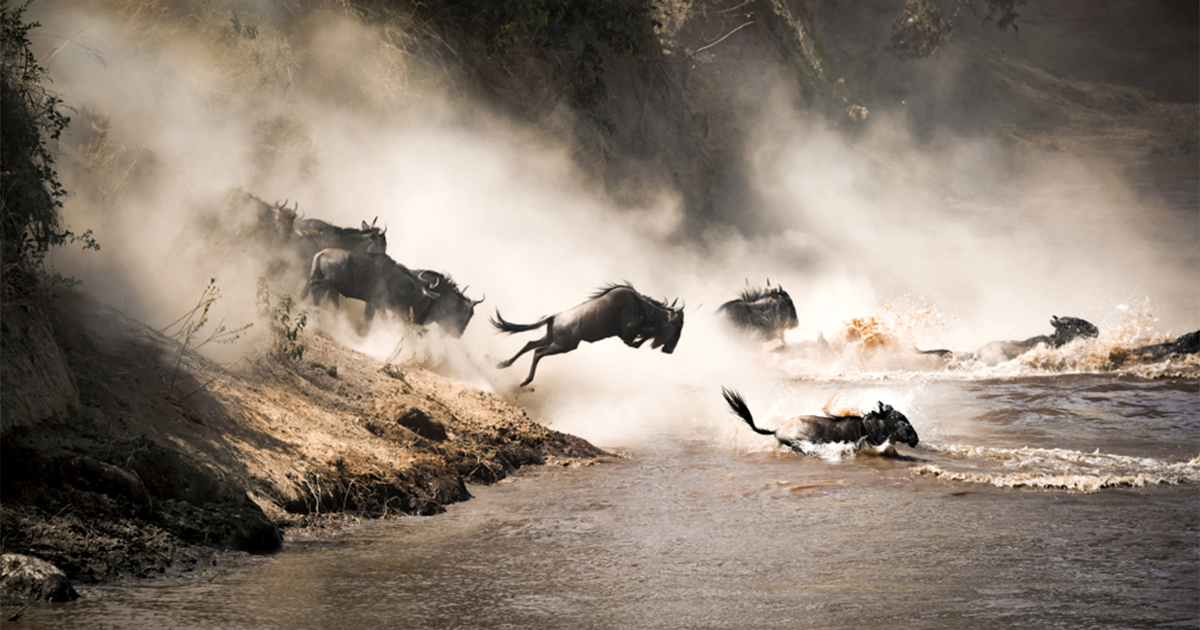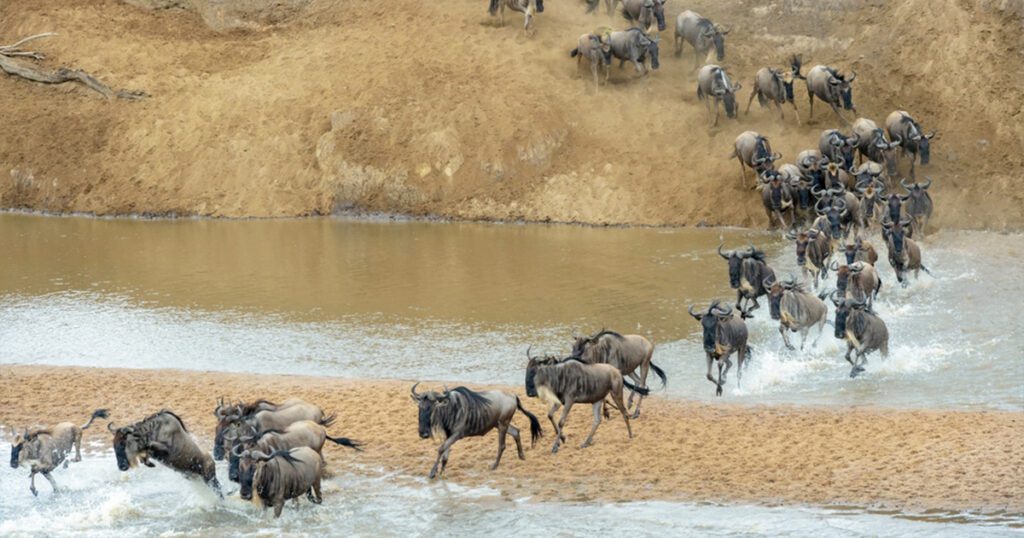
Africa’s Greatest River Crossings
- bySusan Wanjiru
- - July 30, 2024
Home » Blog » Africa’s Greatest River Crossings
Ever watched a single animal fighting tooth and nail for its life? If yes, you know it’s a sight that sears itself into your memory. Now, think about such prey-predator battles amplified on a monumental scale involving millions of wildebeest and their predators. You’ll get an unparalleled adrenaline rush for a lifetime!
This is precisely what the Great Migration promises, especially the iconic river crossings, eagerly anticipated by wildlife enthusiasts around the globe.
In this blog post, we delve into the heart of these breathtaking river crossings. These churning waterways are more than just bodies of water; they are tests of courage, strength, and survival. The river crossings are a defining chapter of the migration, a dramatic and perilous act that showcases the raw power and resilience of nature.
We’ll guide you on what to expect and the best times to witness them. The river crossings have already begun this year, and we’re sure by the end of this blog, you’ll be inspired to experience them firsthand.
Start reading and secure your safari spot before it’s too late!
Experience The Thrill Of Wildebeest Conquering The Grumeti, Mara, and Sand Rivers
The Grumeti River:

Located entirely within Tanzania, the Grumeti River is the first major obstacle encountered by the migrating herds as they head north. This river flows from the western corridor of the Serengeti National Park and meanders westward into the expansive waters of Lake Victoria. While the Grumeti is narrower and less ferocious than the Mara, it still presents a formidable challenge to the migrating herds.
The resident population of hippopotamuses becomes a significant obstacle, their territorial nature creating bottlenecks and chaos within the herds. These massive creatures, with their unpredictable behavior and sheer strength, add an extra layer of danger and intrigue to the crossing. The sight of wildebeest and zebras navigating through waters occupied by these territorial giants is a spectacle that underscores the raw power and social dynamics of the animal kingdom. The more intimate and remote nature of this crossing means fewer tourists, allowing for a more serene and immersive viewing experience.
So, if you’re seeking an extraordinary safari experience that unfolds the awe-inspiring tenacity of the migrating herds and the commanding presence of the resident hippos against the backdrop of the stunning and serene Serengeti, the Grumeti River crossing is an adventure not to be missed!
The Mara River:

Arguably the most iconic river crossing, the Mara River lies on the border between Tanzania’s Serengeti National Park and Kenya’s Masai Mara National Reserve. The Mara River is not just any river; it is a formidable natural barrier, wider and faster flowing than its counterparts. This river teems with an array of predators, particularly the formidable Nile crocodile, which adds an element of high-stakes drama to the already perilous journey of the migrating herds.
Witnessing a Mara River crossing is an experience that can only be described as heart-stopping. The air vibrates with the thunderous sound of thousands of wildebeest hooves, creating a cacophony that echoes for miles. The water churns and foams, turning red with danger as the wildebeest become vulnerable targets for the lurking crocodiles. These prehistoric predators lie in wait, ready to exploit any moment of hesitation or weakness.
The sheer determination and relentless momentum of the herd are awe-inspiring. Watching them push forward, a dynamic tapestry of brown bodies, is a testament to the raw power of nature. Some wildebeest make it across unscathed, their instinct and stamina guiding them to safety. Others are not so fortunate, succumbing to the river’s powerful current or falling prey to the jaws of the resident crocodiles. Each crossing is a microcosm of the circle of life, a poignant reminder of survival and sacrifice.
The Mara River crossing is not only a spectacle of survival but also a display of the intricate social dynamics within the herd. The leading animals often hesitate, gauging the danger before plunging into the water, while the pressure from the massive numbers behind forces a forward surge. The collective will to survive drives them onward, despite the perilous odds.
In addition to the crocodiles, the crossing attracts other predators, such as lions and hyenas, who wait on the riverbanks, ready to seize any opportunity. The river itself is a force to be reckoned with, its swift currents and deep channels presenting a challenge even without the added threat of predators. The Mara River crossing is a crucible of life, where only the strongest and most determined survive.
Prepare to be captivated by the spectacle of the Great Migration at its most dramatic and intense!
The Sand River:

The Sand River marks the boundary between Kenya’s Masai Mara and Tanzania’s Serengeti National Park. This strategic location transforms the Sand River into a crucial crossing point for the migrating herds of wildebeest, zebras, and other animals as they traverse these renowned wildlife reserves during the Great Migration. Unlike the Mara and Grumeti Rivers, the Sand River is relatively drier, presenting its own unique set of challenges and dangers that add to the complexity of this epic journey.
One of the most intriguing aspects of the Sand River crossing is its treacherous quicksand. The unsuspecting animals, driven by the relentless pursuit of greener pastures, often find themselves trapped in the deceptive sands. Once stuck, their struggle to free themselves becomes a battle against time, exhaustion, and the ever-watchful predators. The quicksand transforms the crossing into a perilous endeavor, where every step can be fraught with danger.
The predators of the Sand River have adapted to these conditions in remarkable ways. Taking cover in the sandbanks, lions, hyenas, and other carnivores lie in wait, ready to ambush their unsuspecting prey. The open landscape provides them with an unobstructed view of the passing herds, making it easier to single out and target vulnerable individuals. This strategic advantage makes the predators of the Sand River particularly formidable.
Moreover, the Sand River’s relative dryness means that the animals face the additional challenge of finding water. The scarcity of water in this region makes the journey even more arduous, testing the endurance and survival instincts of the migrating herds. Despite these obstacles, the animals push forward, driven by an ancient, unyielding instinct to migrate.
Witness the ferocious tenacity of the migrating herds and the cunning strategies of their predators in a captivating display of nature’s enduring cycle.
Life from Death: How Wildebeest River Crossings Nourish the Serengeti
The river crossings are more than just a perilous journey for the wildebeest; they are crucial for the ecosystem’s delicate balance. Corpses keep the Serengeti well-fed. As wildebeest and other herbivores brave the treacherous waters, many succumb to the swift currents and predators lying in wait. While this might seem like a grim fate, it is an essential part of the natural cycle that sustains this vibrant landscape.
Scavengers like vultures and Marabou Storks play a pivotal role in this cycle. These avian custodians are quick to descend upon the fallen, transforming death into a vital source of sustenance. By consuming the carcasses, they ensure that nutrients are rapidly recycled back into the ecosystem. This process nourishes the grasslands, fostering new plant growth that will feed the herbivores in the coming seasons.
But the impact of these river crossings extends beyond the terrestrial realm. The large number of wildebeest that drown during this gruelling migration become an unexpected boon for aquatic life. Their floating bodies provide a rich, organic feast for a variety of aquatic organisms, from fish to invertebrates, which in turn support a higher trophic level, including crocodiles and birds.
The annual death toll of these migrations might seem high, but it is a natural and necessary mechanism that supports the Serengeti’s biodiversity. Without it, the balance would be disrupted, leading to consequences that could ripple through the entire ecosystem. This remarkable interplay between life and death highlights the intricate connections that sustain one of the world’s most famous wildlife reserves.
Timing the Drama: Best Seasons to Witness the Serengeti’s River Crossings

In the realm of nature, we operate on her clock, dancing to the rhythm of her whims and caprices. The annual migration of wildebeest, one of the most spectacular wildlife events on the planet, is no exception. This breathtaking spectacle, punctuated by dramatic river crossings, is primarily dictated by the weather, particularly rainfall patterns. Consequently, the schedule of this grand migration is as fluid and unpredictable as the Serengeti rivers themselves.
Typically, the prime window to witness these awe-inspiring river crossings spans from July to October. This period coincides with the dry season in the Serengeti, compelling the herds to move northward in search of greener pastures. The dry, parched landscape and dwindling water sources drive the wildebeest towards the Mara River, where they face the perilous task of crossing its crocodile-infested waters. As the rains recede and the dry season intensifies, the migration gathers momentum.
However, the unpredictability of nature means these patterns can sometimes take unexpected turns. Sudden changes in weather or unforeseen environmental factors can alter the migration timeline, making it a challenging phenomenon to predict with absolute certainty.
This is where Scarface Pride’s expertise becomes invaluable. Our seasoned safari experts, with their profound understanding of the Serengeti’s rhythms, can help you plan your trip to maximize your chances of witnessing this incredible event. By staying attuned to the latest migration updates and environmental cues, our team ensures that your safari experience is nothing short of extraordinary.
Moreover, as the wildebeest begin their southward journey around November to December, following the retreating rains, a different but equally captivating phase of the migration unfolds. This return trek, driven by the promise of replenished grazing lands, offers another opportunity to witness the resilience and determination of these magnificent creatures.
Let us guide you through these intricacies of nature’s clock, ensuring that you are at the right place at the right time to witness the grandeur of the wildebeest migration in all its glory!
Book your safari with Scarface Pride and witness the nuances of nature, unfiltered with your own eyes.
